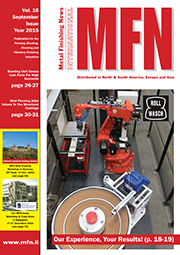E-Archive
Articles
in Vol. 16 - September Issue - Year 2015
Blasting Unit Cleans Cast Parts For High Demands

Ralf Funke, the managing director of Eickhoff Eisengie


AGTOS shotblast machine for parts with a diameter and height of up to 3.5 metres and a work piece weight of up to 20 tonnes
Whether mining machinery or gearing for wind power plants - the products offered by the Eickhoff Group in Bochum, Germany, must withstand very high demands. To be able to meet these requirements, the group runs its own foundry, and purchased for this subsidiary a new turbine-wheel shot-blasting machine manufactured by AGTOS.
Until now, the foundry was forced to transfer large components to an external service provider for blasting, cleaning and painting after they had been removed from the mould. "Frequently, one can see only after blasting whether a part is okay," explains Ralf Funke, the managing director of Eickhoff Eisengießerei GmbH. This awkward situation is now a thing of the past - at Eickhoff, a new blasting machine runs for parts with a diameter and height of up to 3.5 metres and a work piece weight of up to 20 tonnes. "Our parts won't be larger than that,' says Mr. Funke. The employees are now able to check the cast part before it is sent for cleaning and painting.
The machine removes within 20 minutes any adhering mould sand from the cast part and ensures higher surface quality. Because three overhead carriers are available, one carrier will be in the unit while another is loaded or unloaded.
The system is designed as a continuous overhead rail shot-blasting system. The blasting chamber itself has been realised as a rugged bolt construction from high wear-resistant steel. Additionally, 10 mm thick exchangeable wearing plates are installed in the direct blasting area of the turbines. A second chamber for manual after-blasting the cast part is right next to it. The high-performance turbines are installed in-between.
After the program is started, the machine door is closed and locked automatically. The rotating work pieces are blasted in three positions according to the predefined blasting period.
Five turbines with 22 kW driver power each ensure that the sand is reliably removed. The wheels have a diameter of 460 mm each and feature six easily replaceable blades. The blasting agent can reach a release velocity of 106 m/s with an abrasive throughput of 220 kg/min each.
An impeller causes a mechanical pre-acceleration of the abrasive. The control cage allows the setting of the jet range from the outside. Agtos manufactures the turbine housing completely from high wear-resistant manganese steel and additionally lines it with anti-wear linings. Using frequency converters, the desired speed can be specified with a target value per turbine plane on the operating unit. The frequency converters also allow an energy-efficient operation of the blasting system.
The blasting machine at Eickhoff however, features a combined magnetic cyclone separator for use in foundries with very high sand adhesion to the work pieces. The sand is separated from the abrasive-sand mixture by two series-connected magnet rollers. In addition, the abrasive is cleaned by means of cascade air separation. An air stream separates dust and undersized particles from the abrasive. Coarse particles are drawn off and separated by an integrated impact box. Coarse substances such as scale and burr are separated in a screen box. The cleaned abrasive drops into a storage hopper.
The abrasive keeps circulating and is cleaned to allow continuous use. A dosing system is used to transport the cleaned abrasive from the storage hopper to the turbines. Beneath the blasting chamber, a recovery funnel for the abrasive is installed. Coarse components are screened out before the abrasive-sand mixture is sent to the bucket elevator.
Five dosing units are installed each between storage hopper and turbine to feed the abrasive. An electro-pneumatically operated shell valve ensures precise dosing. The adhesive throughput volume is set with an adjusting screw. An inspection opening at the unit's housing enables function checks.
The foundry produces cast pieces in one-off and serial production. "We have 5,000 active articles, process 64 different materials and supply nearly 120 customers," explains Mr. Funke. The core competence is the manufacturing of cast products that have to meet high technological requirements and are generally used in mechanical engineering, oil hydraulics, drive technology, production of fittings and pumps, mining and plastics machinery, and wear-protection technology.
The holding Gebrüder Eickhoff Maschinenbau und Eisengießerei GmbH includes also the subsidiaries Eickhoff Bergbautechnik GmbH, Eickhoff Antriebstechnik GmbH, Eickhoff Maschinenfabrik GmbH and Schalker Eisenhütte Maschinenfabrik GmbH. The mining technology company develops high-performance machines as customised systems. Their core competences are development, design and manufacturing of shearer loaders, and partial face excavators for mining and tunnelling. Eickhoff Antriebstechnik GmbH develops and manufactures industry-specific drives to meet individual customer requirements. Within the group, Eickhoff Maschinenfabrik GmbH manufactures the mechanical components for the products of the drive technology and mining technology subsidiaries. Last but not least, Schalker Eisenhütte Maschinenfabrik GmbH is the provider of coking plant machinery and special-purpose rail vehicles.
For Information:
AGTOS
Gesellschaft für technische
Oberflächensysteme GmbH
Gutenbergstr. 14
48282 Emsdetten, Germany
Tel. +49.2572.96026-0
Fax +49.2572.96026-111
E-mail: info@agtos.de
www.agtos.de




























